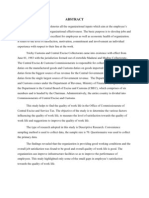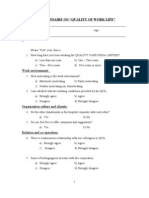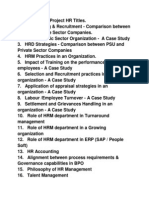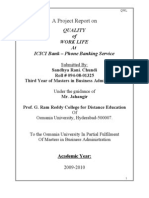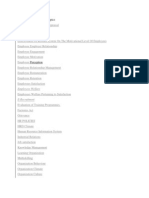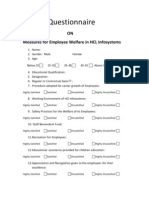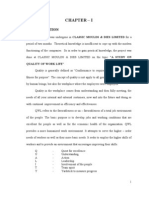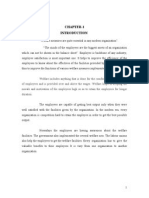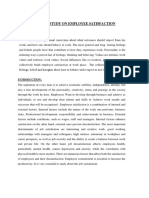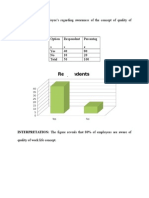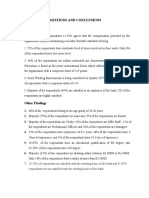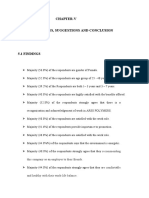Data Analysis QWL
Data Analysis QWL
Uploaded by
Shams SCopyright:
Available Formats
Data Analysis QWL
Data Analysis QWL
Uploaded by
Shams SOriginal Description:
Copyright
Available Formats
Share this document
Did you find this document useful?
Is this content inappropriate?
Copyright:
Available Formats
Data Analysis QWL
Data Analysis QWL
Uploaded by
Shams SCopyright:
Available Formats
1) Are you treated with respect at work place?
Particulars
Strongly agree
agree
neutral
strongly disagree
Total
NO. of Respondens
23
20
7
0
50
Percentage
46%
40%
14%
0%
100%
Interpretation:
From the above table it is concluded that 46% of the employees strongly
agree that they are treated with respect at work place, 40% agree with
that, and 14% are neutral with the query and 0% of the employees
disagree with it.
1) Are you treated with respect at work place?
Percentage
50%
46%
45%
40%
40%
35%
30%
Percentage
25%
20%
14%
15%
10%
5%
0%
Strongly agree
agree
neutral
0%
strongly disagree
2) Are you satisfied with the working conditions
provided by the organization?
Particulars
Very satisfied
satisfied
neutral
dissatisfied
Total
NO. of Respondens
16
25
5
4
50
Percentage
32%
50%
10%
8%
100%
Interpretation:
According to the data shown in the above table, it is clear that 50% of the
respondents are satisfied with the working condition provided by the
organizatin, 32% are highly satisfied where 10% are neutral on the query
and the rest 8% are dissatisfied with the working condition.
2) Are you satisfied with the working conditions
provided by the organization?
Percentage
50%
50%
45%
40%
35%
32%
30%
Percentage
25%
20%
15%
10%
8%
10%
5%
0%
Very satisfied
satisfied
neutral
dissatisfied
3) How often do you feel stressful during your work?
Particulars
Always
often
sometimes
never
Total
NO. of Respondens
8
28
14
0
50
Percentage
16%
36%
28%
0
100%
Interpretation:
According to the data gathered, it is said by the respondents that 36% feel
stress often during their work, 16% say that always feel stressful during
their work, 28% says that they feel stressful sometimes and overall
nobody says they dont feel stressful i.e. 0%
3) How often do you feel stressful during your work?
Percentage
40%
36%
35%
28%
30%
25%
20%
Percentage
16%
15%
10%
5%
0%
Always
often
sometimes
0%
never
4) Do the departments co-operate each other well in
your organization?
Particulars
To a great extent
To some extent
Moderate
Total
NO. of Respondens
26
18
6
50
Percentage
62%
36%
12%
100%
Interpretation:
According to the data shown, it is clear that most of the employees
i.e. 36% feel thecoperation between different departments is well to
some extent, and according to 62% the cooperation between the
department is up to a great extent, and 12% say it is moderate.
4) Do the departments co-operate each other well in
your organization?
Percentage
11%
To a great extent
To some extent
Moderate
33%
56%
5) Are your suggestions considered in the organization?
Particulars
Yes
No
Total
NO. of Respondens
36
14
50
Percentage
72%
28%
100%
Interpretation:
From the above table it is clear that 72% of the feels that their
suggesstions are considered in the organization, and 28% of the
respondets feel that it is not and they say no.
5) Are your suggestions considered in the organization?
Percentage
28%
Yes
No
72%
6) Are the new policies and strategies communicated to
employees?
Particulars
Very often
sometimes
moderate
not at all
Total
NO. of Respondens
28
13
6
3
50
Percentage
62%
26%
12%
6%
100%
Interpretation:
From the above table it is concluded that 62% of the employees feels that
tnew policies and strategies are communicated to them, 26% feel that
sometimes they come to know about new policies and strategies, where
12% feel it moderately and 6% say they not at all communicated about it
to them.
6) Are the new policies and strategies communicated to
employees?
Percentage
70%
62%
60%
50%
Percentage
40%
26%
30%
20%
12%
6%
10%
0%
Very often
sometimes
moderate
not at all
7) The relationship of your colleagues is harmonious
with you and others?
Particulars
Strongly Agree
agree
neutral
disagree
Total
NO. of Respondens
24
21
2
3
50
Percentage
48%
42%
4%
6%
100%
Interpretation:
From the above data in the table, shows that 48% of the respondents
strongly agree with harmonious relation among employees, 42% of the
respondents simply agree with it, 6% of the respondents are disagrring
with it, and the rest 4% are neutral on it.
7) The relationship of your colleagues is harmonious
with you and others?
Percentage
4%
6%
Strongly Agree
agree
48%
42%
neutral
disagree
8) Do the training programs help in developing Quality
of work life?
Particulars
To a great extent
to some extent
moderate
not at all
Total
NO. of Respondens
15
28
7
0
50
Percentage
30%
56%
14%
0
100%
Interpretation:
It is clear from the above table, that 56% of the employees that the
training program helps them in developing Quality of their work life to
some extent, 30% feel that it help to a great extent, 14% feel moderate
about the training program over quality of work life.
8) Do the training programs help in developing Quality
of work life?
Percentage
14%
30%
To a great extent
to some extent
moderate
not at all
56%
9) How far training programs help an employee to
achieve the required skill for performing the job
effectively?
Particulars
To a great extent
To some extent
Rarely
Total
NO. of Respondens
32
18
0
50
Percentage
64%
36%
0%
100%
Interpretation:
From the above table it is shown that 64% of the respondents feel that
training programs helpsto a great extent in achieving required skills
performance of job, 36% feel it helps them to some extent and 0% says
rarely.
9) How far training programs help an employee to
achieve the required skill for performing the job
effectively?
Percentage
70%
64%
60%
50%
Percentage
36%
40%
30%
20%
10%
0%
To a great extent
To some extent
0%
Rarely
10) Do you think the training programs help in
improving relationship among employees?
Particulars
Yes
No
Total
NO. of Respondens
28
22
50
Percentage
56%
44%
100%
Interpretation:
From the above table it is concluded that 56% of the respondents believes
that training program helps in developing the relationship among
employees, and the rest 44% say No, it doesnt help in improving
relationships.
10) Do you think the training programs help in
improving relationship among employees?
Percentage
Yes
44%
No
56%
11) Are the employees given fair and adequate
compensation for the work they perform?
Particulars
Certain
Good
sufficient
moderate
Total
NO. of Respondens
14
21
8
7
50
Percentage
28%
42%
16%
14%
100%
Interpretation:
From the above table it is concluded that 42% of the respondents say that
compensation given to employees for their work is Good, 28% say it is
certain, 16% says the compensation is sufficient and 14% say it is
moderate.
11) Are the employees given fair and adequate
compensation for the work they perform?
Percentage
42%
45%
40%
35%
28%
30%
Percentage
25%
16%
20%
14%
15%
10%
5%
0%
Certain
Good
sufficient
moderate
12) Does the superiors give genuine feed back?
Particulars
Yes
No
Total
NO. of Respondens
38
12
50
Percentage
86%
24%
100%
Interpretation:
It is shown from the above table, that the feed given by the superiors is
genuine accroding to 86% of the respondents, but 24% of the respondents
see it is not a genuine feed back.
12) Does the superiors give genuine feed back?
Percentage
22%
Yes
No
78%
13) What is your opinion on fringe benefits in the
organization?
Particulars
Excellent
Good
Average
Poor
Total
NO. of Respondens
25
15
10
0
50
Percentage
50%
30%
20%
0%
100%
Interpretation:
From the above table it is concluded that 50% of the respondents opined
that the fringe benefits in the organization are excellent, 30% says that it
is good, and the rest 20% says fringe benefits have average impact on
them.
13) What is your opinion on fringe benefits in the
organization?
Percentage
50%
50%
45%
40%
35%
30%
30%
Percentage
25%
20%
20%
15%
10%
5%
0%
Excellent
Good
Average
0%
Poor
14) What is your perception about the career planning
program in the organization?
Particulars
Wide
Fine
Narrow
Poor
Total
NO. of Respondens
28
15
5
2
50
Percentage
56%
30%
10%
4%
100%
Interpretation:
According to the above data, it is said that 56% of the respondents feels
that the career planning program in this organization is wide, 30%
believes it s fine and 10% says it is narrow career planning, and the
remaining 4% perceive it is poor planning over career of employees.
14) What is your perception about the career planning
program in the organization?
Percentage
60%
56%
50%
40%
Percentage
30%
30%
20%
10%
10%
4%
0%
Wide
Fine
Narrow
Poor
15) What is your view about the pay structure in the
organization?
Particulars
Excellent
Good
Average
Poor
Total
NO. of Respondents
26
14
10
0
50
Percentage
52%
28%
20%
0%
100%
Interpretation:
The above table is aimed to show the employees perception over
pay structure of the organization and it is said that according to 52% of
the respondents that pay structure is excellent, 28% of the respondents
say it is good and 20% say it is moderate and no response was against the
pay structure of the organization that is 0%
15) What is your view about the pay structure in the
organization?
Percentage
60%
52%
50%
40%
Percentage
28%
30%
20%
20%
10%
0%
Excellent
Good
Average
0%
Poor
16) Do you feel secure about your job?
Particulars
NO. of Respondens
Percentage
Yes
38
76%
No
12
24%
Total
50
100%
Interpretation:
From the above table which is aimed to show the job security of
employees, it is concluded that 76% of the respondents feels their job is
secured and answered Yes, and the rest 24% do not feel secure about
their job and says no.
16) Do you feel secure about your job?
Percentage
24%
Yes
No
76%
17) What is your perception about the sensible
integration of job, career, family life and leisure time?
Particulars
NO. of Respondens
Percentage
Excellent
11
22%
Good
30
60%
Average
16%
Poor
2%
Total
50
100%
Interpretation:
According to the above table, 60% of respondents perceive that
integration of life apart from jobs are good in the organization, 22%
perceive it as excellent, and the 16% perceive it average and the
remaining 2% say it is poor.
17) What is your perception about the sensible
integration of job, career, family life and leisure time?
Percentage
2%
16%
Excellent
Good
Average
Poor
22%
60%
18) Are you satisfied with the leave provided by the
organization?
Particulars
Extremely Satisfied
Satisfied
Neutral
Dissatisfied
Total
NO. of Respondens
29
14
7
0
50
Percentage
58%
28%
14%
0%
100%
Interpretation:
From the above table it is concluded that 58% of the
respondents are extremely satisfied with the leave policy of the
organization, 28% are satisfied with it and 14% of the
respondents are neutral over the query asked.
18) Are you satisfied with the leave provided by the
organization?
Percentage
60%
58%
50%
40%
Percentage
28%
30%
20%
14%
10%
0%
Extremely Satisfied
Satisfied
Neutral
0%
Dissatisfied
19) Does you organization provide free transport
facility?
Particulars
Yes
No
Total
NO. of Respondens
35
15
50
Percentage
70%
30%
100%
Interpretation:
The above table is aimed to notify whether the organization
provides transport facility for its employees, and the most of the
respondents that is 70% say Yes, and the rest 30% say no.
20) Does you organization provide free transport
facility?
Percentage
30%
Yes
No
70%
20) What is your perception over job satisfaction?
Particulars
Excellent
Good
Average
Poor
Total
NO. of Respondens
30
15
5
0
50
Percentage
60%
30%
10%
0%
100%
Interpretation:
From the above table it is concluded that most of the respondents
are satisfied with their job, according to 60% of the employees perceive
their job is excellent, 30% of the respondents perceive their job is good,
10% of the respondents of the perceive their job is average over their
perception and no respondents perceive the job is poor.
21) What is your perception over job satisfaction?
Percentage
10%
Excellent
Good
30%
60%
Average
Poor
You might also like
- In My Mind's Eye - Ursula FrankeDocument156 pagesIn My Mind's Eye - Ursula FrankeAlice Sepheeris100% (8)
- Organization of Psychological Training in The Armed Forces of UkraineDocument326 pagesOrganization of Psychological Training in The Armed Forces of UkraineSarah Ashton Cirillo75% (4)
- Literature Review Customer ServiceDocument7 pagesLiterature Review Customer ServiceShams S83% (6)
- Data AnalysisDocument20 pagesData AnalysisSandeep Dava75% (4)
- A Project Report On Quality of Work LifeDocument79 pagesA Project Report On Quality of Work Lifessgayathri2786% (104)
- QWL QuestionnaireDocument3 pagesQWL Questionnairekuldip singh67% (3)
- Abhinav Reddy Quality of Work Life at HDFC BankDocument79 pagesAbhinav Reddy Quality of Work Life at HDFC BankSri0% (1)
- Questionnaire OlayDocument1 pageQuestionnaire OlayShams S100% (1)
- Horlicks ProjectDocument56 pagesHorlicks ProjectShams S83% (36)
- Horlicks ProjectDocument56 pagesHorlicks ProjectShams S83% (36)
- Applied Linguistics Lecture 2Document17 pagesApplied Linguistics Lecture 2Dina BensretiNo ratings yet
- Data Analysis MotivationDocument30 pagesData Analysis MotivationIbrahimKhaleelNo ratings yet
- Quality of Work LifeDocument68 pagesQuality of Work Lifesajithasabari60% (5)
- Questionnaire On Quality of Work LifeDocument6 pagesQuestionnaire On Quality of Work Lifepreetbai100% (1)
- Questionnaire On Quality of Work LifeDocument5 pagesQuestionnaire On Quality of Work Lifechennai.ibrahim72% (18)
- Quality of Work Life PDFDocument85 pagesQuality of Work Life PDFjoao1504100% (1)
- Appendix A Study On Performace Appraisal in Brainstorm InfotechDocument3 pagesAppendix A Study On Performace Appraisal in Brainstorm InfotechSivalinga RajaNo ratings yet
- Quality of Work Life - HDFC BANKDocument100 pagesQuality of Work Life - HDFC BANKArunKumar50% (4)
- A Study On Quality of Work Life in KMR TextilesDocument69 pagesA Study On Quality of Work Life in KMR TextilesThilaka Shanmugam63% (8)
- MBA Internship Project HRDocument3 pagesMBA Internship Project HRNeha DhawanNo ratings yet
- Quality of Work Life in B.H.E.L.Document90 pagesQuality of Work Life in B.H.E.L.DESH RAJ BHANDARI82% (17)
- BibliographyDocument10 pagesBibliographyRasa Govindasmay100% (1)
- Quality of Work Life - Project 2010Document67 pagesQuality of Work Life - Project 2010Chillara Sai Kiran Naidu60% (5)
- Quality Work LifeDocument12 pagesQuality Work LifePriya MudgalNo ratings yet
- List of Top HR Project Topics For MBADocument5 pagesList of Top HR Project Topics For MBASaran RajNo ratings yet
- A Study On Quality of Work Life Balance in DSM Textile at KarurDocument94 pagesA Study On Quality of Work Life Balance in DSM Textile at KarureswariNo ratings yet
- A Study On Quality of Work Life of Employees COMDocument129 pagesA Study On Quality of Work Life of Employees COMVishnu Priya50% (2)
- Questionnaire On Effectiveness of Training and DevelopmentDocument3 pagesQuestionnaire On Effectiveness of Training and DevelopmentyamunaNo ratings yet
- A Employee Welfare Measures in TSNPDCLDocument7 pagesA Employee Welfare Measures in TSNPDCLMaskamanNo ratings yet
- Questionnaire:: I Will Be Thankful To You If You Please Fill The FollowingDocument4 pagesQuestionnaire:: I Will Be Thankful To You If You Please Fill The FollowingSandipNaradNo ratings yet
- Questionnaire For Quality of WorklifeDocument3 pagesQuestionnaire For Quality of WorklifeKow Salya71% (7)
- List of MBA HR Project Topics: Employees WelfareDocument25 pagesList of MBA HR Project Topics: Employees Welfarechandrasudhir100% (1)
- Welfare Measures QuestionnaireDocument3 pagesWelfare Measures QuestionnaireAnkita Singh50% (4)
- A Study On Effect of Welfare Measures On Employee MoraleDocument57 pagesA Study On Effect of Welfare Measures On Employee MoralesupigopiNo ratings yet
- A Study On Employee Satisfaction Survey at Roots Cast Private Limited CoimbatoreDocument96 pagesA Study On Employee Satisfaction Survey at Roots Cast Private Limited CoimbatoreArun100% (4)
- Questionnaire On Training and DevelopmentDocument3 pagesQuestionnaire On Training and DevelopmentKunal Sonetta100% (2)
- Project Report On Effect of Welfare Measures On EmployeesDocument28 pagesProject Report On Effect of Welfare Measures On EmployeesGio Joy0% (1)
- Quality of Work LifeDocument77 pagesQuality of Work Lifes. sowmyaNo ratings yet
- A Study On Employee Involvement Towards Teamwork in Madurai Meenakshi Mission Hopital and Research Centre MaduraiDocument68 pagesA Study On Employee Involvement Towards Teamwork in Madurai Meenakshi Mission Hopital and Research Centre Madurairose30cherryNo ratings yet
- Job Satisfaction Questionnaire PDFDocument3 pagesJob Satisfaction Questionnaire PDFShibu ThakurNo ratings yet
- Mba HR - Project Topics: Page - 1Document2 pagesMba HR - Project Topics: Page - 1santoshNo ratings yet
- QUESTIONNAIREDocument4 pagesQUESTIONNAIREDivya HalpatiNo ratings yet
- Employee MotivationDocument3 pagesEmployee MotivationA Aminul Jesima KaboorNo ratings yet
- A Project On Quality of Work LifeDocument59 pagesA Project On Quality of Work LifeBattula Raghunath ReddyNo ratings yet
- G.sreeman Project - Labour Welfare ManagementDocument68 pagesG.sreeman Project - Labour Welfare ManagementRakesh SharmaNo ratings yet
- Review of Literature: Misra, K.K (1974) - Labour Welfare in Indian Industries, Meerut, Meenakshi PrakashanDocument36 pagesReview of Literature: Misra, K.K (1974) - Labour Welfare in Indian Industries, Meerut, Meenakshi PrakashanalwinNo ratings yet
- MBA+Project Quality+of+Work+Life (1) .Document60 pagesMBA+Project Quality+of+Work+Life (1) .Divya Ram100% (1)
- Project FullDocument117 pagesProject FullEzhil ArasuNo ratings yet
- Questionnaire On Training and DevelopmentDocument9 pagesQuestionnaire On Training and DevelopmentRohit RainaNo ratings yet
- PercepionDocument20 pagesPercepionSuvarna RajuNo ratings yet
- Data Analysis and Interpretation: For Leading A Comfortable Work Life?Document28 pagesData Analysis and Interpretation: For Leading A Comfortable Work Life?Sahil GouthamNo ratings yet
- SIS Analysis and InterpretationDocument11 pagesSIS Analysis and InterpretationSaurabh PoteNo ratings yet
- Final Report 1Document22 pagesFinal Report 1Doll DollNo ratings yet
- Unt Dallas Faculty SatisfactionDocument20 pagesUnt Dallas Faculty SatisfactionEric NicholsonNo ratings yet
- On Employee NewDocument32 pagesOn Employee NewSachin MundeNo ratings yet
- Chapter-4 SUMMARY AND CONCLUSIONDocument4 pagesChapter-4 SUMMARY AND CONCLUSIONRahul ThakurNo ratings yet
- Quality of Working Life AnalysisDocument10 pagesQuality of Working Life AnalysisVarun JainNo ratings yet
- Chapter No 4Document18 pagesChapter No 4Avi ShekawatNo ratings yet
- Ashish-Project1mirza Q. Repaired)Document35 pagesAshish-Project1mirza Q. Repaired)Ashish ShuklaNo ratings yet
- Non TeachingDocument30 pagesNon TeachingEdwin Okoampa BoaduNo ratings yet
- Scope of The StudyDocument21 pagesScope of The StudySivanarayan SandeepNo ratings yet
- Findings, Suggestions and Conclusions Major FindingsDocument4 pagesFindings, Suggestions and Conclusions Major FindingsShaji VargheseNo ratings yet
- Age of The RespondentsDocument33 pagesAge of The RespondentsBalaji KrishnanNo ratings yet
- BPO - Akash Agarwal (TYBMS) 1112186Document29 pagesBPO - Akash Agarwal (TYBMS) 1112186Rahul BhansaliNo ratings yet
- Chapter - VDocument9 pagesChapter - VPriyanga .A.MNo ratings yet
- Que PDFDocument13 pagesQue PDFSunny DhirNo ratings yet
- Pepsi Project ReportDocument74 pagesPepsi Project ReportShams SNo ratings yet
- Employee MotivationDocument78 pagesEmployee MotivationShams SNo ratings yet
- DerivativesDocument75 pagesDerivativesDowlathAhmedNo ratings yet
- Ratio AnalysisDocument64 pagesRatio AnalysisShams SNo ratings yet
- Recruitment QuestionnaireDocument2 pagesRecruitment QuestionnaireShams S100% (1)
- Mouryaa Inn ProfileDocument9 pagesMouryaa Inn ProfileShams SNo ratings yet
- A Questionnaire On Quality of Work Life Name: Designation: AgeDocument3 pagesA Questionnaire On Quality of Work Life Name: Designation: AgeShams SNo ratings yet
- Samsung Galaxy Brand ImageDocument63 pagesSamsung Galaxy Brand ImageShams SNo ratings yet
- Loans and AdvancesDocument64 pagesLoans and AdvancesShams SNo ratings yet
- Review of LiteratureDocument2 pagesReview of LiteratureShams SNo ratings yet
- Findings and SuggestionsDocument2 pagesFindings and SuggestionsShams SNo ratings yet
- Employee Motivation QuestionnaireDocument2 pagesEmployee Motivation QuestionnaireShams S89% (9)
- Types of LoansDocument5 pagesTypes of LoansShams SNo ratings yet
- Employee Motivation QuestionnaireDocument2 pagesEmployee Motivation QuestionnaireShams S89% (9)
- History of Toothbrushes and ToothpastesDocument15 pagesHistory of Toothbrushes and ToothpastesShams SNo ratings yet
- Training Need AssessmentDocument90 pagesTraining Need AssessmentShams S100% (1)
- Theoretical Background of The Customer Satisfaction.Document3 pagesTheoretical Background of The Customer Satisfaction.Shams S67% (6)
- Cust Satisfaction ArielDocument32 pagesCust Satisfaction ArielShams SNo ratings yet
- Cust Satisfaction ArielDocument32 pagesCust Satisfaction ArielShams SNo ratings yet
- Hero Satisfaction ProjDocument59 pagesHero Satisfaction ProjShams S100% (2)
- Pepsodent Proj Color PrintsDocument13 pagesPepsodent Proj Color PrintsShams SNo ratings yet
- Colgate Dental CreamDocument3 pagesColgate Dental CreamShams SNo ratings yet
- Base Form Simple Past Past ParticipleDocument3 pagesBase Form Simple Past Past ParticipleShams SNo ratings yet
- Use of Do and Have VerbsDocument10 pagesUse of Do and Have VerbsShams SNo ratings yet
- QuestionnaireDocument2 pagesQuestionnaireShams SNo ratings yet
- Occupational TherapyDocument27 pagesOccupational TherapyHadeel Mahmoud Ezzat MohamedNo ratings yet
- Poor CharlieDocument12 pagesPoor CharlieSashidhar PrasadNo ratings yet
- ODF3 Unit 1 Vocabulary PracticeDocument2 pagesODF3 Unit 1 Vocabulary PracticeKate PodbrezskaNo ratings yet
- RESEARCH-PAPER - QualitativeDocument10 pagesRESEARCH-PAPER - QualitativeGrace MandrezaNo ratings yet
- Google AIMLDocument2 pagesGoogle AIMLemmanuel.bungaNo ratings yet
- Bipolar Mood DisorderDocument7 pagesBipolar Mood DisorderMary Rose Silva GargarNo ratings yet
- Lesson 5Document4 pagesLesson 5api-409519927No ratings yet
- Star Trek RPG - LUG - Blood & Honor - The KlingonsDocument6 pagesStar Trek RPG - LUG - Blood & Honor - The KlingonsAshs BoomstickNo ratings yet
- A Study On Role of Woman in Leadership Positions: June 2021Document5 pagesA Study On Role of Woman in Leadership Positions: June 2021pramodNo ratings yet
- Letter To God Dust of Snow Fire N Ice NotesDocument8 pagesLetter To God Dust of Snow Fire N Ice Notessiya.ambwaniNo ratings yet
- Daily Lesson Log: 11 Oral Communication in Context FirstDocument4 pagesDaily Lesson Log: 11 Oral Communication in Context FirstWinnelyn ReyesNo ratings yet
- Speech About LifeDocument1 pageSpeech About LifeAlexa Luisa HistorilloNo ratings yet
- WHLP Grade 6 Q2 W2 All SubjectsDocument13 pagesWHLP Grade 6 Q2 W2 All SubjectsGERALDINE PATUBONo ratings yet
- Oral Com Q2 W1Document7 pagesOral Com Q2 W1Kay Tracey Urbiztondo100% (1)
- GermanlitDocument6 pagesGermanlitapi-551541045No ratings yet
- Abstract: This Meta-Analysis Research Estimated and Compared The Differences Between The AcademicDocument3 pagesAbstract: This Meta-Analysis Research Estimated and Compared The Differences Between The Academictristan calaraNo ratings yet
- Placement ReportDocument2 pagesPlacement ReportKim PossibleNo ratings yet
- Functions of Non-Verbal CommunicationDocument19 pagesFunctions of Non-Verbal CommunicationAli KhaqaanNo ratings yet
- CLEMENTE - RDL2 - WEEKLY LP - W7 - Nov 2-5Document3 pagesCLEMENTE - RDL2 - WEEKLY LP - W7 - Nov 2-5Liezel G. ClementeNo ratings yet
- Yehuda Fried, Joseph Agassi Auth. Paranoia A Study in Diagnosis PDFDocument230 pagesYehuda Fried, Joseph Agassi Auth. Paranoia A Study in Diagnosis PDFLuiz BruderNo ratings yet
- M4 - Literacy TrainingDocument5 pagesM4 - Literacy TrainingPrincess PulintanNo ratings yet
- Handbook For Lean Futures Creation v.2.0Document43 pagesHandbook For Lean Futures Creation v.2.0Denisa UngurNo ratings yet
- Learning Outcomes:: The Material SelfDocument65 pagesLearning Outcomes:: The Material SelfRejasNo ratings yet
- Lesson 4 Philosophical EthicsDocument25 pagesLesson 4 Philosophical EthicsalexaNo ratings yet
- Contempory Management Issues Assignment HelpDocument11 pagesContempory Management Issues Assignment HelpHND Assignment Help OneNo ratings yet
- Rubric For WeeblyDocument1 pageRubric For Weeblyapi-710038660No ratings yet
- Frames Semantics Charles FillmoreDocument14 pagesFrames Semantics Charles FillmoreJoel Arturo Pedraza NicolasNo ratings yet




